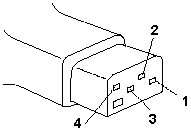|
AC Adapter (60W) Test the A/C Adapter Battery Pack Test the Battery Pack Test the Backup Battery Back to 8554 Common Devices
Power Management: Suspend/resume: An application is suspended by closing the clamshell leaving the power switch on. When the clamshell is opened, the application resumes at the point it was suspended. During suspension, system components are automatically powered off except for the real time clock and application memory. Changing the rechargeable battery pack will not disrupt the application, since IBM PS/2 NiMH Battery Pack II consists of two batteries, replace one at a time. AC Adapter (60W) includes an internal (3 hour) quick charger that recharges the IBM PS/2 NiMH Battery Pack II automatically while the system is connected to an AC-power source. Sleep mode. Sleep mode conserves battery power during idle times between clock cycles and key strokes by putting system components in an idle state resulting in low power usage. Application, operational, operating system and environmental characteristics will affect actual battery duration between recharges. IBM PS/2 AC Adapter (60W) P/N 06G8451 The IBM PS/2 AC Adapter (60W) includes an internal (3 hour) quick charger that recharges the IBM PS/2 NiMH Battery Pack II automatically while the system is connected to an AC-power source. >>Anyone out there know where I can find an AC adapter for a CL57sx? Or, does anyone know if any of IBM's other laptops used the same AC adapter? FAIK the CL57SX uses a unique AC-Adapter which hasn't been used anywhere else. Don't forget that the CL57 is a PS/55 machine originally - designed and built for domestic japanese market only. >The DC input plug looks like that:
GND is "protective GND" - means there is a zero Ohms resistance between this pin and the third pin on the power supply. "Minus" is the DC GND return for "Plus" and "CC" (Battery Charger Voltage). "Code" is a hole in the plug, into which a plastic pin goes to avoid
accidentially plugging it upside down (which is more than unlikely due
to the form of the plug already ...)
Test the A/C Adapter If the Power-On indicator is not on, check the power cord of the AC adapter for proper installation and continuity. 1. If any noise can be heard from the AC adapter when it is plugged into line voltage, replace the AC adapter with a new one. If no noise can be heard from the adapter, go to Step 3. 2. If the noise still comes from the new AC adapter, suspect the computer. Replace the AC adapter with the original one, then go to the next step. If no noise comes from the new adapter, the original adapter has the problem. 3. Unplug the AC adapter cable from the computer and measure the output voltages at the plug of the AC adapter cable. Connect the minus lead of the volt-ohm meter to pin 3 during the measurement. 
Pin Vdc 1 +18 to +22 2 +17 to +21 3 GND 4 Communication GND If the voltages are not correct:
If the voltages are OK
IBM PS/2 NiMH Battery Pack II P/N 07G1418 FRU 07G1413 12v, 1.4 AH IBM PS/2 External Rechargeable Power Pack II P/N 34G9851 Peter says:
Inside are
The cells are industrial standard with sheetmetal contacts. These are nickel-plated and hard to solder. They are usually point-welded, but soldering works as well if you roughen the surfaces with a piece of sandpaper. Cells are similar to NH GP 181AFH-1Z (1.810 mAh / 1.2V / 4/5A), which cost about 5.75 Euro per one at Reichelt in Germany - according to an old 2004-catalogue. You could take the NH GP 121AAM-1Z as well (for 2.50 Euro), but these offer 1.100 mAh only and are a tad thinner in diameter. Individual mileage may vary and I think they came cheaper and with various sources to pick from. Have taken pictures from the crap-out. Maybe I'll buy 10 cells to revive at least one battery, but before I need to solve the keyboard problem. Should be possible. I'd even found a solution with that silly DS1287 ... 8554 on Gel Cells
Al Savage
Smokey Behr
Test the Battery Pack First, remove each battery and measure the voltage between (+) and (-). 
Terminal (V dc)
If < +12v, the pack is discharged or defective.
2. Using a low-power ohm meter, measure the resistance between (T) and
(-). The resistance must be 500 ohms to 20 kilohms. If the resistance is
out of range, replace the battery pack.
Test the Backup Battery 35G2282 1. Remove the keyboard and the top cover. 2. Disconnect the battery connector from the system board. 3. Measure the voltage of the backup battery. 
Wire Vdc Red +2.5 to +3.7 Black Ground If voltage is correct, replace system board. If not, the battery was shorted out or is defective. |